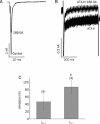18β-Glycyrrhetinic acid preferentially blocks late Na current generated by ΔKPQ Nav1.5 channels
- PMID: 22609834
- PMCID: PMC4010371
- DOI: 10.1038/aps.2012.22
18β-Glycyrrhetinic acid preferentially blocks late Na current generated by ΔKPQ Nav1.5 channels
Abstract
Aim: To compare the effects of two stereoisomeric forms of glycyrrhetinic acid on different components of Na(+) current, HERG and Kv1.5 channel currents.
Methods: Wild-type (WT) and long QT syndrome type 3 (LQT-3) mutant ΔKPQ Nav1.5 channels, as well as HERG and Kv1.5 channels were expressed in Xenopus oocytes. In addition, isolated human atrial myocytes were used. Two-microelectrode voltage-clamp technique was used to record the voltage-activated currents.
Results: Superfusion of 18β-glycyrrhetinic acid (18β-GA, 1-100 μmol/L) blocked both the peak current (I(Na,P)) and late current (I(Na,L)) generated by WT and ΔKPQ Nav1.5 channels in a concentration-dependent manner, while 18α-glycyrrhetinic acid (18α-GA) at the same concentrations had no effects. 18β-GA preferentially blocked I(Na,L) (IC(50)=37.2 ± 14.4 μmol/L) to I(Na,P) (IC(50)=100.4 ± 11.2 μmol/L) generated by ΔKPQ Nav1.5 channels. In human atrial myocytes, 18β-GA (30 μmol/L) inhibited 47% of I(Na,P) and 87% of I(Na,L) induced by Anemonia sulcata toxin (ATX-II, 30 nmol/L). Superfusion of 18β-GA (100 μmol/L) had no effects on HERG and Kv1.5 channel currents.
Conclusion: 18β-GA preferentially blocked the late Na current without affecting HERG and Kv1.5 channels.
Figures






Similar articles
-
Characterization of a novel multifunctional resveratrol derivative for the treatment of atrial fibrillation.Br J Pharmacol. 2014 Jan;171(1):92-106. doi: 10.1111/bph.12409. Br J Pharmacol. 2014. PMID: 24102184 Free PMC article.
-
18β-Glycyrrhetinic acid potently inhibits Kv1.3 potassium channels and T cell activation in human Jurkat T cells.J Ethnopharmacol. 2013 Jul 9;148(2):647-54. doi: 10.1016/j.jep.2013.05.022. Epub 2013 May 21. J Ethnopharmacol. 2013. PMID: 23707333
-
Glycyrretinic acid blocks cardiac sodium channels expressed in Xenopus oocytes.J Ethnopharmacol. 2009 Sep 7;125(2):318-23. doi: 10.1016/j.jep.2009.06.016. Epub 2009 Jun 25. J Ethnopharmacol. 2009. PMID: 19559778
-
Cardiac arrhythmias: the genetic connection.J Cardiovasc Electrophysiol. 2000 May;11(5):601-2. doi: 10.1111/j.1540-8167.2000.tb00016.x. J Cardiovasc Electrophysiol. 2000. PMID: 10826942 Review. No abstract available.
-
QT interval prolongation and cardiac risk assessment for novel drugs.Curr Opin Investig Drugs. 2003 Mar;4(3):303-8. Curr Opin Investig Drugs. 2003. PMID: 12735231 Review.
Cited by
-
Evaluation of Cx43 Gap Junction Inhibitors Using a Quantitative Structure-Activity Relationship Model.Biomedicines. 2023 Jul 12;11(7):1972. doi: 10.3390/biomedicines11071972. Biomedicines. 2023. PMID: 37509611 Free PMC article.
-
Coupling the Cardiac Voltage-Gated Sodium Channel to Channelrhodopsin-2 Generates Novel Optical Switches for Action Potential Studies.Membranes (Basel). 2022 Sep 20;12(10):907. doi: 10.3390/membranes12100907. Membranes (Basel). 2022. PMID: 36295666 Free PMC article.
-
Pharmacological Features of 18β-Glycyrrhetinic Acid: A Pentacyclic Triterpenoid of Therapeutic Potential.Plants (Basel). 2023 Mar 1;12(5):1086. doi: 10.3390/plants12051086. Plants (Basel). 2023. PMID: 36903944 Free PMC article. Review.
-
Natural products modulating the hERG channel: heartaches and hope.Nat Prod Rep. 2017 Aug 2;34(8):957-980. doi: 10.1039/c7np00014f. Nat Prod Rep. 2017. PMID: 28497823 Free PMC article. Review.
-
Inhibitory effects of glycyrrhetinic Acid on the delayed rectifier potassium current in Guinea pig ventricular myocytes and HERG channel.Evid Based Complement Alternat Med. 2013;2013:481830. doi: 10.1155/2013/481830. Epub 2013 Aug 29. Evid Based Complement Alternat Med. 2013. PMID: 24069049 Free PMC article.
References
-
- Hale SL, Shryock JC, Belardinelli L, Sweeney M, Kloner RA. Late sodium current inhibition as a new cardioprotective approach. J Mol Cell Cardiol. 2008;44:954–67. - PubMed
Publication types
MeSH terms
Substances
Supplementary concepts
LinkOut - more resources
Full Text Sources
Miscellaneous

